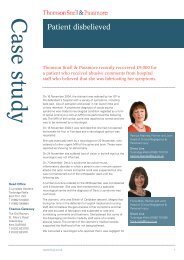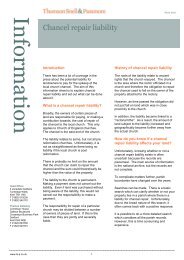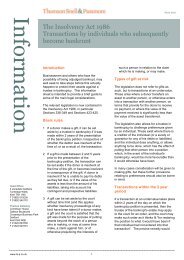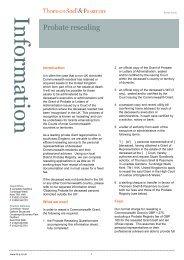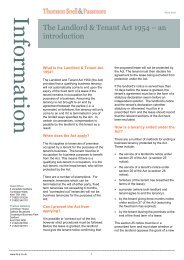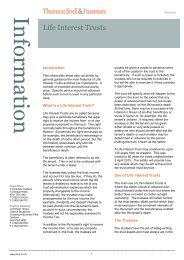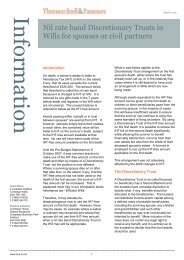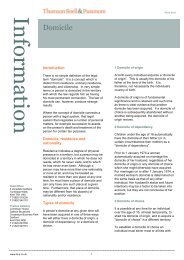The Thames Gateway Regeneration Project - Thomson Snell and ...
The Thames Gateway Regeneration Project - Thomson Snell and ...
The Thames Gateway Regeneration Project - Thomson Snell and ...
Create successful ePaper yourself
Turn your PDF publications into a flip-book with our unique Google optimized e-Paper software.
<strong>The</strong> <strong>Thames</strong> <strong>Gateway</strong> <strong>Regeneration</strong> <strong>Project</strong> –A business perspectivewww.ts-p.co.uk
IntroductionBetween September 2005 <strong>and</strong> June 2006 partners at leading regional law firm <strong>Thomson</strong> <strong>Snell</strong> & Passmore (TS&P)undertook detailed face-to-face interviews with 51 companies in the North Kent area of the <strong>Thames</strong> <strong>Gateway</strong> region –representing a combined turnover of £3 billion <strong>and</strong> employing over 11,000 people.All types of businesses were represented in the study, from sole traders to international corporations. Sectorscovered included construction/real estate, manufacturing, education/training, hotels & leisure, transport & logistics,business services, Housing Associations, professions, consumer services, insurance, retail, health <strong>and</strong> mining.<strong>The</strong> interviews covered topics as far reaching as awareness of the regeneration project <strong>and</strong> attitudes towards its likelyimpact, communication with the development agencies, views on infrastructure development, the local workforce<strong>and</strong> the commercial challenges specific to the participating companies <strong>and</strong> their sectors.This report summarises the main findings of the research <strong>and</strong> provides valuable insight into how the <strong>Thames</strong> <strong>Gateway</strong><strong>Regeneration</strong> <strong>Project</strong> is currently viewed by the indigenous business community <strong>and</strong> how it might develop in the future.
About <strong>The</strong> <strong>Thames</strong> <strong>Gateway</strong><strong>The</strong> <strong>Thames</strong> <strong>Gateway</strong> is the largest regeneration zone inWestern Europe <strong>and</strong> has been identified by the Government as anational priority for regeneration <strong>and</strong> growth. It extends for 40miles along the River <strong>Thames</strong> from London Dockl<strong>and</strong>s toSouthend in Essex <strong>and</strong> Sheerness in Kent.<strong>The</strong> <strong>Thames</strong> <strong>Gateway</strong> has 1.6 million residents, approximately700,000 households <strong>and</strong> currently supports some 500,000 jobs.Its development potential lies in the 3,800 hectares of brownfieldl<strong>and</strong>, much of it being former docks, warehousing, industrial <strong>and</strong>quarries, as well as its location – it is next to the economic heartof London <strong>and</strong> directly en route to the accessible markets ofNorth West Europe.Reproduced with the permission from <strong>The</strong> Department for Communities <strong>and</strong> Local GovernmentAbout <strong>The</strong> <strong>Thames</strong> <strong>Gateway</strong> <strong>Regeneration</strong> <strong>Project</strong><strong>The</strong> Government’s vision is to transform the region by:building 120,000 homes by 2016creating up to 180,000 jobscreating sustainable communities with good local facilities,services <strong>and</strong> jobs <strong>and</strong> transport links to access services, jobs<strong>and</strong> trainingimproving educational facilities to enhance the local skills base<strong>and</strong> enable people to move from declining industries intogrowing economic sectorsbringing major improvement to the image <strong>and</strong> environment ofthe <strong>Gateway</strong>, including higher quality design <strong>and</strong> attractiveopen spaces, with improved access to the river.<strong>The</strong> development is split into zones each with a different agencyresponsible for delivery:In LondonLondon <strong>Thames</strong> <strong>Gateway</strong> Development Corporation(includes Lower Lea Valley <strong>and</strong> London Riverside – Barking &Dagenham, Havering & Newham)Woolwich <strong>Regeneration</strong> Agency <strong>and</strong> Greenwich PartnershipBexley <strong>Regeneration</strong> Partnership.<strong>The</strong>re are nine zones of change in London:Isle of DogsGreenwich, Deptford <strong>and</strong> LewishamStratfordLower LeaRoyal DocksBarking Town CentreLondon RiversideCharlton to Crayford.For the EastThurrock <strong>Thames</strong> <strong>Gateway</strong> Development CorporationBasildon Renaissance PartnershipRenaissance Southend.<strong>The</strong>re are three zones in South Essex:ThurrockBasildon <strong>and</strong> Castle PointSouthend <strong>and</strong> Rochford.For South EastKent <strong>Thames</strong>ide Delivery Board (Dartford & Gravesham)Medway Renaissance PartnershipSwale Forward.<strong>The</strong>re are four zones of change in North Kent:Kent <strong>Thames</strong>ideGrainMedwaySittingbourne-Sheerness.Reproduced with the permission from <strong>The</strong> Department for Communities <strong>and</strong> Local Government1
About <strong>Thomson</strong> <strong>Snell</strong> & Passmore in the<strong>Thames</strong> <strong>Gateway</strong>TS&P attributes much of its success to having lawyers who reallytake the time to underst<strong>and</strong> clients <strong>and</strong> their needs. So when thefirm considered opening a new office in the <strong>Thames</strong> <strong>Gateway</strong>area its first priority was to learn about the issues facingbusinesses in the area <strong>and</strong> to underst<strong>and</strong> their requirements forprofessional advice.<strong>The</strong> partners in the <strong>Thames</strong> <strong>Gateway</strong> team representing theconstruction, property, dispute resolution, employment <strong>and</strong>commercial disciplines, devoted time to this research project tolearn first h<strong>and</strong> <strong>and</strong> from the horse’s mouth what the <strong>Thames</strong><strong>Gateway</strong> business community thought <strong>and</strong> wanted. <strong>The</strong> firmopened its <strong>Thames</strong> <strong>Gateway</strong> office in May 2005.Whilst providing the firm with valuable insight into how to servethe area better, the firm believes that the survey information willalso be valuable to the local authorities, development agencies<strong>and</strong> other bodies who are tasked with developing theappropriate infrastructure <strong>and</strong> realising the area’s potential. <strong>The</strong>broader community will also benefit from learning how theirbusiness colleagues view the present <strong>and</strong> future challenges forboth enterprise <strong>and</strong> individuals <strong>and</strong> what can be done to ensurethat the area continues to succeed <strong>and</strong> grow. Those interviewedalmost exclusively come from the South East region of <strong>The</strong><strong>Thames</strong> <strong>Gateway</strong> <strong>Regeneration</strong> <strong>Project</strong> (Appendix 1 provides anoutline of the planned regeneration taking place in closeproximity to them).About <strong>Thomson</strong> <strong>Snell</strong> & PassmoreTS&P is a leading regional law firm in the South East (with a HeadOffice based in Tunbridge Wells, Kent). <strong>The</strong> firm servicesrequirements across the legal spectrum, has recognised expertisein all practice areas <strong>and</strong> a reputation based on a tradition of clientcare going back to 1570. With over 80 lawyers <strong>and</strong> employing afurther 120 staff, the firm possesses a strength <strong>and</strong> depth ofexpertise which only a h<strong>and</strong>ful of firms can claim in the SouthEast outside London. In addition, the firm boasts 11 lawyers whoare recognised as leaders in their field (Chambers Guide to theLegal Profession 2006/2007).AcknowledgementsTS&P would like to thank the senior executives of the 51organisations who participated in this research. <strong>The</strong> firm wouldalso like to thank the many authorities, agencies <strong>and</strong> professionalswho gave freely their time <strong>and</strong> expertise in supporting the firm’swork to date in the <strong>Thames</strong> <strong>Gateway</strong> area.2
Executive summary<strong>The</strong> main findings of the research were as follows:About the <strong>Thames</strong> <strong>Gateway</strong> <strong>Regeneration</strong><strong>Project</strong>Whilst many of those interviewed appear to lack detailedinformation about the <strong>Thames</strong> <strong>Gateway</strong> <strong>Regeneration</strong> <strong>Project</strong>,the majority of the businesses regard the project positively <strong>and</strong>are cautiously optimistic about the benefits that it will bring.However, 78% of the respondents believe the new jobs <strong>and</strong>new businesses created by the project will present a realchallenge for local businesses <strong>and</strong> nearly half of the sample feelthat the needs of London are being given too much emphasisover the needs of North Kent.<strong>The</strong>re are significant concerns about the transportinfrastructure for the region <strong>and</strong> the increased future pressureon local services. Nearly all participants identified healthprovision as being a particular challenge. Concern also extendsto the perceived conflicts between the planned increase inhousing <strong>and</strong> the needs of local business <strong>and</strong> industry.One of the most worrying results was that 70% of thoseinterviewed reported that they had not been consulted abouttheir views on or needs of the regeneration project. Ofthose who had been consulted, it was largely as a result oftheir own initiative as they are in construction <strong>and</strong> propertyrelated organisations. Attitudinal responses indicate that twothirds of the sample had not been made to appreciate thesignificance of the developments. More positively, two thirdsof the businesses interviewed were positive about thelikelihood of being involved in future consultation projects.One explanation for the apparent lack of communication <strong>and</strong>involvement is that the regeneration project is beingsupported by so many different delivery bodies that themessage has become fragmented. <strong>The</strong> Government <strong>and</strong> localdevelopment agencies therefore need to work more closelytogether <strong>and</strong> invest more in communicating with <strong>and</strong> involvinglocal businesses – particularly the smaller enterprises – in theregeneration project <strong>and</strong> conveying the full range of initiativesplanned <strong>and</strong> their likely impact.Another concern is that amongst those interviewed there is ahuge diversity of opinion in terms of the critical success factorsfor successful regeneration which indicates that the developmentagencies are facing many <strong>and</strong> varied expectations.Issues facing <strong>Thames</strong> <strong>Gateway</strong> businesses<strong>The</strong> major issue of concern for those interviewed appears tobe recruitment – particularly with regards to the availability ofappropriately skilled staff at an affordable level. This iscompounded by the fear that new businesses created orattracted by the regeneration project will increase competitionfor skilled workers. Businesses see the development of thelocal workforce as a top priority.Many of the businesses interviewed are experiencingmanagement issues with strategy, planning, managing growth<strong>and</strong> marketing – which could be rapidly <strong>and</strong> relatively easilyremedied by greater provision of business advice by eitherpublic or private sources. Yet over 50% of those questionedfelt that they were effectively serviced by the local provision ofprofessional financial, legal, property <strong>and</strong> business services.A significant number of the participating businesses indicatedfinancial issues – whether this was in managing day-to-daycash flow or for investment in organic or acquisition growth.This would suggest that banks <strong>and</strong> private finance providerswould need to look carefully at the particular needs ofbusinesses in the area if the opportunities to grow createdby regeneration are to be realised.Legislation, regulation <strong>and</strong> increased Government interventionare high on the agenda for many businesses within the<strong>Thames</strong> <strong>Gateway</strong> – as they are for all businesses within theUK. TS&P has already begun to address this need by itsinnovative programme of free seminars in 2006 which havehelped nearly 300 businesses in the <strong>Thames</strong> <strong>Gateway</strong> learnmore about the law <strong>and</strong> its impact on their business today <strong>and</strong>in the future. <strong>The</strong> next series of seminars will commence inMarch 2007.<strong>The</strong>re is a wealth of additional detailed information regarding theparticipants’ detailed views of the regeneration project <strong>and</strong> itsimplications for transport, health, education, utilities <strong>and</strong> socialamenities, which are not, for the sake of space, published inthis document.3
Research resultsBusiness issuesIssues facing your organisation?Whilst the range of responses to this question wasunderst<strong>and</strong>ably varied some key common issues emerged. Inorder of the most frequent responses the top ten issues are:GFHEIJDCABA Recruitment issues – particularly thelack of skilled workersB Competition – split evenly betweenUK <strong>and</strong> overseasC Regulation – keeping up withnumerous laws <strong>and</strong> regulationsD Expansion – premises, planning,recruitment etcE Planning – both general business <strong>and</strong>marketing planningF Service improvementG EconomyH Keeping existing clientsI Creating new businessJ Business mergers <strong>and</strong> takeoversWhilst some of these might be seen as constraints, what theyindicate is that with suitable action – such as workforcedevelopment at a regional level <strong>and</strong> business support to assistwith managing planning, expansion <strong>and</strong> compliance – there is awill <strong>and</strong> significant potential for growth within the area. <strong>The</strong>re isclearly a need for more business support advice provided by thepublic <strong>and</strong> private sectors.“<strong>The</strong> three main issues facing my business are 1) finding newbusiness, 2) retaining existing business (it is very competitive),3) bureaucracy – employment law <strong>and</strong> health & safety”Commercial services<strong>The</strong>re were many comments relating to the increased overheadfrom Government intervention <strong>and</strong> bureaucracy in areas asdiverse as minimum wages, emission regulations, environmentalcontrols <strong>and</strong> health & safety regulations. In terms of l<strong>and</strong> <strong>and</strong>property, there was frequent mention of areas of outst<strong>and</strong>ingbeauty, green belt assignment <strong>and</strong> planning restrictions constrainingdevelopment <strong>and</strong> expansion. This suggests that either specialprovisions need to be made within the regeneration area or thatadditional advice <strong>and</strong> support should be provided to help<strong>Thames</strong> <strong>Gateway</strong> businesses cope with these issues.“1) Planning – the length of time taken to processapplications 2) Inl<strong>and</strong> Revenue red tape <strong>and</strong> 3) the lack ofqualified personnel” Construction/property development“Labour costs, legislation (especially employment) <strong>and</strong>business rates” ManufacturingSeveral respondents mentioned a lack of public <strong>and</strong> privatefunding which suggests a greater dem<strong>and</strong> for investment. Thiscan either be encouraged by the development agencies orprovided by local private equity providers. <strong>The</strong>re were alsoseveral mentions of mergers <strong>and</strong> acquisitions leading to marketconsolidation <strong>and</strong> the impact that this will have on smallerbusinesses <strong>and</strong> customers. This would suggest that the localbusiness support agencies <strong>and</strong> advisers tailor their services to theneeds of the smaller organisations.“For our business, the issues are; acquisition of furthersuitable sites; climate controls <strong>and</strong> protecting our local climate;local factors such as unemployment, local economy etc”Leisure“TUPE issues. Staff recruitment. Information <strong>and</strong> the need toknow what is likely to happen in the future”Property management“Demonstrating that we are providing a good service <strong>and</strong>improving performance/quality <strong>and</strong> efficiency (getting bestvalue from our resources)” Housing“Corporate takeover <strong>and</strong> market strategy. Operations in nicheindustries such as cars, fresh fruit <strong>and</strong> steel exports – stabilityof these sectors is crucial for us” Transport<strong>The</strong>re were a few mentions of the changing nature of the areawith concerns that further provision for housing <strong>and</strong> greaterenvironmental controls combined with increased competition willlead to a further reduction in the little remaining manufacturingwithin the area.Issues facing your sector?Considering the variety of sectors represented in the study, wewere surprised to find a high degree of consistency in the issuesmentioned. In order of the most frequent responses the top tenissues are:GFEHIDJCABA Skills shortageB Legislation <strong>and</strong> regulationC CompetitionD EconomyE Financial managementF Government supportG Strategy <strong>and</strong> planningH L<strong>and</strong>/property resourcesI Social change/attitudesJ Market uncertainty4
“We are growing <strong>and</strong> hungry for space but are limited due toplanning limitations. A number of the local areas are stronglyprotected by the environmental lobby. Some l<strong>and</strong> has beenearmarked for housing but not enough for industry. You simplycannot have everybody commuting to work as fuel is avaluable <strong>and</strong> diminishing resource so you need localemployment. Fruit packaging <strong>and</strong> distribution are bothexp<strong>and</strong>ing” TransportOf these issues, only Government support <strong>and</strong> l<strong>and</strong>/propertyresources would appear to be specific to the <strong>Thames</strong> <strong>Gateway</strong>region. Perhaps easiest to address would be an immediateincrease in the funding for the local agencies to provide furthermuch needed support for the local business community –whether this is for training <strong>and</strong> development, access tomanagement advice or information on market changes <strong>and</strong> howto respond. More challenging perhaps, would be greaterinformation about the available l<strong>and</strong> <strong>and</strong> property bank <strong>and</strong> thelikely future dem<strong>and</strong>, <strong>and</strong> perhaps a relaxation of some of therestrictions to enable development in the short term.“Our industry is in a mess – there is over-capacity <strong>and</strong> adisorganised structure. <strong>The</strong>re is also a lot of competitiveness”Manufacturing“Changes in legislation. Social changes in what is acceptable<strong>and</strong> greater emphasis on home life. Need to raise the profileof childcare – it is seen as a soft industry but is actually verytough <strong>and</strong> therefore we need to attract the right type of people”Childcare/education<strong>The</strong> other issues are those commonly experienced throughoutthe UK business community. <strong>The</strong> prevalence of financialmanagement, business strategy <strong>and</strong> costs <strong>and</strong> pricing issueswould suggest gaps in the <strong>Thames</strong> <strong>Gateway</strong> market for which,hopefully, local agencies <strong>and</strong> professionals can provide assistancein the short term. New consultancy firms may assist in the longerterm as the region develops.“Cash flow, planning structures <strong>and</strong> future workload”Professional services<strong>The</strong>re was significant evidence of the impact of internationalissues on business in the <strong>Thames</strong> <strong>Gateway</strong> area, whetherfrom overseas competition in Eastern Europe or the Far East,escalating fuel <strong>and</strong> raw material costs or fluctuating exchange <strong>and</strong>inflation rates. This would suggest the need for greater help forbusiness in underst<strong>and</strong>ing (<strong>and</strong> anticipating) international trends<strong>and</strong> markets. Aligned to this issue was the frequently reportedchallenge of keeping abreast of all the information about present<strong>and</strong> future domestic market changes – on a general level as wellas for particular sectors. This would suggest the need for agreater degree of collaboration between businesses in the<strong>Thames</strong> <strong>Gateway</strong> area – so that the burden of collecting marketinformation <strong>and</strong> research can be shared. Such collaboration mayalso lead to a more cohesive voice for the local businesscommunity in lobbying for the resources <strong>and</strong> changes it needs.Perhaps one of the existing business membership organisationscan step into this role. It would certainly seem that a greaterdegree of communication amongst the construction <strong>and</strong> propertybased organisations would lead to more focused action on thel<strong>and</strong> <strong>and</strong> building issues.“Too much red tape, including legislation from Europe –pollution control, paperwork. A lack of joined up thinking <strong>and</strong>strategy. Poor infrastructure <strong>and</strong> a gridlocked road system”Aggregates“Overseas competition. Smaller customers disappearingtherefore playing with the bigger boys who are further drivingdown prices” Equipment sales“Profit margin. Regulations. Competition from Europe – whichhas cheaper overheads” Distribution/logistics“Falling retail prices. Transparency of internet pricing. Marketstability” Importer/export“Government change. Legislation. Keeping abreast of marketwants <strong>and</strong> needs” Education/training<strong>The</strong>re were several mentions of the role of the media inthwarting the success of the region – whether this was innegative or unbalanced reporting of the regeneration project,insufficient support given to local businesses or creating unrealisticexpectations in terms of property <strong>and</strong> investment opportunities.“<strong>The</strong>re is an upward trend but the press, publicity <strong>and</strong> localmessage is wrong” Wholesale/distribution5
Local financial, professional <strong>and</strong> business advice servicesDo you believe that business in this region is effectively cateredfor by the provision of?:ServiceBanking servicesAccountancy servicesLegal servicesProperty consultantsBusiness interest groupsYes55%59%59%57%58%No36%29%29%25%42%Don’t know9%12%12%18%0%Whilst these figures would indicate a pleasing level of satisfactionamongst those interviewed, it is clear that there is still room forimprovement. A significant number of responses indicated thatservice was patchy <strong>and</strong> dependent on specific locations, <strong>and</strong> thatthere was a large number of smaller providers. In addition theneeds of particularly large or medium sized businesses were notadequately being met <strong>and</strong> there were several indications of useof advisers outside the <strong>Thames</strong> <strong>Gateway</strong> area (although notnecessarily London).Business interest groups mentioned included Business Link,Chamber of Commerce (North Kent), Federation of SmallBusinesses, Institute of Directors <strong>and</strong> River Medway BusinessUsers Association. Many respondents acknowledged that they didnot get involved with their local business support groups <strong>and</strong>several commented that there was duplication <strong>and</strong> confusion in<strong>and</strong> about the services provided by different groups.When asked what else would benefit them, the respondentsrequested more diversity at networking events <strong>and</strong> greaterprovision for those in tourism <strong>and</strong> retail sectors. <strong>The</strong>re wereseveral requests for more vehicles to exchange businessinformation – led by local entrepreneurs rather than public agencies.Regular bulletins about progress <strong>and</strong> plans for the area <strong>and</strong> fornews of businesses moving into the region were also requested.“Something centred around the issues of construction, who isdoing what, where <strong>and</strong> when” Construction“<strong>The</strong>re is no forum for North Kent in terms of tourismservices. <strong>The</strong> South East of Engl<strong>and</strong> tourist board used to bequite active in this area but it is not clear what body hasreplaced it <strong>and</strong> how it works” Retail/wholesale“More vehicles for the exchange of business information <strong>and</strong>opportunities” Commercial services“Networking groups outside of the Chamber of Commerce<strong>and</strong> Institute of Directors to talk about business issues. Aforum for business leaders to share ideas, information <strong>and</strong> tonetwork in order to bring together people from differentbackgrounds” Housing“I would like to see more facilitation for larger employers onissues such as recruitment, education etc”Electronics manufacturing6
Awareness of the <strong>Thames</strong> <strong>Gateway</strong><strong>Regeneration</strong> <strong>Project</strong>What do you know about the <strong>Thames</strong> <strong>Gateway</strong><strong>Regeneration</strong> <strong>Project</strong>?<strong>The</strong> respondents were split into three groups: those that have ahigh degree of knowledge, those that have some knowledge <strong>and</strong>those that have little knowledge. <strong>The</strong> construction <strong>and</strong> propertycompanies were the main members of the group with a highdegree of knowledge. <strong>The</strong> individual responses indicate thatwhere an initial incorrect impression had been formed, nofurther attention was paid to the potential impact <strong>and</strong> benefits tobusiness. Many responses indicated that individuals may havepicked up on just one element of the project such as theproposed housing development.CBAA Very LittleB A littleC A lot“Familiar with sustainable communities agenda through theODPM <strong>and</strong> Swale Forward who liaise with local <strong>and</strong> centralagencies. We work with the ODPM <strong>and</strong> with SEEDA <strong>and</strong> soare fully conversant <strong>and</strong> familiar with the sustainablecommunities agenda. We have a slightly more limitedengagement with the wider project” Housing“Developing the whole of the Eastern corridor by bringing innew industries <strong>and</strong> housing” Education“I know that they are building 180,000 new homes but noinformation otherwise” Transport <strong>and</strong> distribution“<strong>The</strong> <strong>Thames</strong> <strong>Gateway</strong> is an exp<strong>and</strong>ing area. <strong>Regeneration</strong>sums up what is happening. From what I can see it is good<strong>and</strong> of high quality <strong>and</strong> that infrastructure is being provided”Professional services“I don’t know a great deal. <strong>The</strong>re is meant to be a lot ofhousing but the figures vary. I imagine that local authoritiesrequire mixed use <strong>and</strong> therefore some commercial <strong>and</strong>residential development is planned. <strong>The</strong>re is a lot of moneycoming into the area” Construction“We are aware of it. We have been to several seminars throughthe Institute of Directors <strong>and</strong> local Chamber of Commerce.It has been talked about a fair amount” Human resourcesOverall, the results showed that despite good events by anumber of bodies such as the Institute of Directors, localChambers of Commerce, Common Purpose <strong>and</strong> SEEDA, theoverall communications programme had been ineffective for themajority of the respondents <strong>and</strong> that the opportunity exists toinvolve local businesses <strong>and</strong> alert them to the support that mightbe available to them.It was interesting to note that a significant number of respondentsrelied solely on information that was reported in the local press<strong>and</strong> as such had an incomplete or unbalanced view of the project(for example housing issues reported more fully than businessissues, focus on major developments such as Ebbsfleet or portdevelopment). This reliance on local reporting – <strong>and</strong> its naturalfocus on issues relevant to residents <strong>and</strong> consumers – may haveinadvertently reinforced the incorrect view that the project wasof little significance to local businesses.“Remarkably little. Only what we see in the press – that a lotof houses are being built on a flood plain <strong>and</strong> in quarries”Electronics“Only what I have read in the local paper” Construction“General knowledge but you must realise that TG Essex <strong>and</strong>TG Kent are two different things” Office supplies7
What are your initial views about the <strong>Thames</strong> <strong>Gateway</strong><strong>Regeneration</strong> <strong>Project</strong>?Despite the reported lack of detailed knowledge of theregeneration project, 50% of those interviewed felt positivelyabout the project <strong>and</strong> could see the huge potential <strong>and</strong>opportunities it would bring. <strong>The</strong>re was recognition that it was anambitious long term project <strong>and</strong> that this would ensureimprovements were sustainable. Some acknowledged that thearea was desperately in need of development <strong>and</strong> drew parallelswith the stunning results achieved at Canary Wharf. Somecommented on the visible improvements that were alreadyevident <strong>and</strong> the increased confidence amongst the public.“<strong>The</strong> Government must encourage businesses into the area. Itis a sensible area to be improving in view of proximity toFrance <strong>and</strong> the continent” Insurance“A project designed to pump considerable Governmentfunding into the area to improve st<strong>and</strong>ards <strong>and</strong> facilities bothsocially <strong>and</strong> economically. <strong>The</strong> <strong>Thames</strong> needs to be broughtback to life as does this region <strong>and</strong> the Government fundingput in place is designed to ensure that happens” Childcare“It comes out in the press in a haphazard way, e.g. 50,000new homes along the river. I spent a lot of time working atCanary Wharf <strong>and</strong> if we could do something similar I think itwill be successful. <strong>The</strong> area has a lot of wasted space <strong>and</strong>general depression after the dockyard. Providing all theinfrastructure preparatory work is done then I am positive”Travel“Disappointed that Manston is not the third airport as thiswould have been very good for Kent <strong>and</strong> very few houseswould be affected. Otherwise the project is very good forKent, for the economy <strong>and</strong> for the UK as a whole”Insurance“It is a major project. Employment <strong>and</strong> housing will increase<strong>and</strong> create wealth. It has a positive spin <strong>and</strong> everybody istalking about it. People are talking about communities <strong>and</strong>not just bricks <strong>and</strong> mortar” Property development“It would be great if in fact it actually happens” AutomotiveOthers were concerned about the infrastructure deficiencies <strong>and</strong>the slow progress <strong>and</strong> some saw an inherent conflict betweenthe needs of housing <strong>and</strong> industry or the impact on local people<strong>and</strong> local businesses. <strong>The</strong>re was a minority who were cynical <strong>and</strong>sceptical <strong>and</strong> more than a few who felt that the project neededto be “more joined up” – particularly with regards to theinterdependencies between increased housing <strong>and</strong> greaterdem<strong>and</strong> for local services <strong>and</strong> the impact on business.“A lot of talk. Moving away from the traditional manufacturingindustries – square pegs in round holes” Manufacturing“A little sceptical. From an industrial sense, it all appears to beabout building a lot of houses <strong>and</strong> improving the quality of lifebut what are all these people going to do for work apart frombuilding, plumbing etc? What is going to be manufacturedhere? Major industry appears to be leaving these shoresanyway <strong>and</strong> so what will all these extra new people do otherthan possibly commute to London?” Manufacturing“Not quite joined up the dots, good idea but too manyquangos <strong>and</strong> consultants <strong>and</strong> not confident that they willpromote local suppliers” Construction<strong>The</strong> major concern here is that half of the respondents hadneutral or negative attitudes towards the project which againsuggests that greater effort should be made to communicate theaims <strong>and</strong> progress of the project <strong>and</strong> to involve more of thebusiness community (<strong>and</strong> the local people) in the project.8
Awareness of types of businesses growing or looking tolocate in the area?60% of the respondents said that they were not aware of thetypes of business growing within or those looking to locate intothe area compared to 40% who felt they were aware.“In terms of relocation it is essentially the service industriessuch as call centres. In terms of those growing there are thedistribution/logistics companies, call centres, finance houses<strong>and</strong> banks” Human resources“Moving out of London for cheaper <strong>and</strong> better qualityheadquarters, smaller businesses are trying to grow – mostlywarehousing, printing <strong>and</strong> manufacturing industries”Building constructionAre you aware of any of the proposed developments inKent <strong>Thames</strong>ide, Medway <strong>and</strong> Swale?Over half of those interviewed were not aware of the specificdevelopments. Whilst 15 said they were aware of developments inall three areas, eight mentioned Medway <strong>and</strong> a further six saidthey were aware of developments in Kent <strong>Thames</strong>ide <strong>and</strong> Swale.This suggests that communication about the proposeddevelopments has been on a local basis <strong>and</strong> that those within theregion generally were not aware of how the various projectsthroughout the regeneration project were linked. <strong>The</strong> ‘bigpicture’ has not been communicated effectively.Has your organisation been approached by any local orregional government bodies or intermediaries to getyour views on what North Kent needs?A total of 70% said that they had not been consulted. Ofthose who responded positively – most of these were in theconstruction or property sectors. No recurring agency wasmentioned but Kent County Council, Business Link, CommonPurpose, Chamber of Commerce <strong>and</strong> SEEDA were mentionedonce each. This supports the above views that with so manydifferent authorities <strong>and</strong> delivery agencies involved, the messagehas not reached many businesses.Interestingly, a large number of those questioned reported thatthis research project by <strong>Thomson</strong> <strong>Snell</strong> & Passmore was the firsttime that their views were elicited <strong>and</strong> it was therefore the firsttime that they had considered seriously what they hoped theregeneration would achieve for them.Is your organisation involved or aware of any projectsor initiatives which are intended to give localcommunities the opportunity to contribute ideas to<strong>and</strong> benefit from the regeneration project?BAgain, this result echoes the other findings. Three quarters ofthose interviewed felt there was little or no involvement for thecommunities in the regeneration project – a worrying indicationof the perceived lack of involvement of those more likely to beaffected by the project. <strong>The</strong> need for better communications isagain underlined.If not, do you think this is something which yourorganisation would get involved with in the future?CCABAA NoB Yes – knowC Yes – involvedA No/unlikelyB Yes/possiblyC Don’t know/no comment<strong>The</strong> good news for the likely success of the project overall is thatthe vast majority of businesses surveyed would be keen to getinvolved in projects to help local communities contribute ideas to<strong>and</strong> benefit from the regeneration project. Such a wealth ofpotential support should be harnessed <strong>and</strong> directed by thoseresponsible for the projects although it is unclear which agencymight take on this task.9
Impact of the regeneration project on businessHow has your business been affected or how do youexpect your business to be affected by the <strong>Thames</strong><strong>Gateway</strong> <strong>Regeneration</strong> <strong>Project</strong>?PositiveOver half of those who perceived the impact positively saw thekey opportunities as being more business, better transport <strong>and</strong>infrastructure <strong>and</strong> better training/skills. A third saw more generalbenefits such as economic <strong>and</strong> environmental improvements<strong>and</strong> expansion.Overall, those with a positive view saw the regeneration projectattracting more (<strong>and</strong> larger) businesses, more people <strong>and</strong> moreinvestment to the area, which in turn would lead to morewealth, more customers <strong>and</strong> increased dem<strong>and</strong> for theirproducts <strong>and</strong> services as well as increased property asset values<strong>and</strong> a more positive attitude by local people.Some commented on the value of an improved profile <strong>and</strong>awareness of the area <strong>and</strong> its improved accessibility toLondon leading to a range of benefits including a better locallabour market.Negative<strong>The</strong> majority of those viewing the impacts negatively saw the lackof infrastructure <strong>and</strong> the ensuing traffic congestion as a concern.<strong>The</strong>re were various mentions of the wisdom of housing <strong>and</strong>major developments in flood plain areas <strong>and</strong> concerns that theproject was focused too much on housing with insufficientattention paid to other regeneration such as industry.<strong>The</strong>re were contradictory views about the impact on the localworkforce – some feared the enhanced train links would lead toan outflow of quality local workers whilst others saw theincreased population facing a dearth of well paid local jobs.One respondent commented on the need for regeneration to beconsidered at a regional level rather than a local level to avoidunanticipated problems being created in nearby areas of Kent.Others feared that resources <strong>and</strong> attention would be focused onnew communities at the expense of established ones.How do you think the proposed developments in Kent<strong>Thames</strong>ide, Medway <strong>and</strong> Swale might impact onyour business?EDG H IFCJBADon't know/no commentPositivelyNo impactMore people purchasing commercialproperty in the areaIncreased businessNot applicableMore people coming into the areaLose out to competitionBetter infrastructureProvide industrial developments“Greater number of rental properties <strong>and</strong> more people lookingto buy” Property investment“Nothing would damage our ability to perform <strong>and</strong> we onlysee potential benefits” Electronics“Positively – always opportunities. Stock transfers will berelevant” Housing“Favourably provided that the zoned areas for industrialdevelopment remain as they have been discussed with us”Industrial processing“Cynically the big boys will have all of it – if the £1 million to£2 million one-off jobs soak up all the labour” Construction“It will worsen the road system <strong>and</strong> therefore congestion.Financially I do not believe it will make any difference”PrintingWhere there was awareness of the developments, the reactionwas largely positive with an increase in business, betterinfrastructure <strong>and</strong> more people moving into <strong>and</strong> buying in the areaanticipated. A concern is that half of those interviewed wereunaware of the developments <strong>and</strong> therefore unable to commenton what the impact on their business might be. This lack ofawareness could be a threat to indigenous North Kent businesses.ABCDEFGHIJOther key concerns were increased competition – particularly iflarger businesses won the lion’s share of resources <strong>and</strong> benefits –<strong>and</strong> overcrowding. <strong>The</strong>re were also fears about priority beinggiven to larger companies, increased environmental protectionism<strong>and</strong> increased dem<strong>and</strong> on local services <strong>and</strong> resources.10
Factors affecting the success of theregeneration projectDo you underst<strong>and</strong> what is meant by the phrase“building sustainable communities”? If so, what do youthink are the key components?<strong>The</strong> incredibly varied responses to this question would indicatethe need for a clear <strong>and</strong> concise definition of the term <strong>and</strong> itsimplications <strong>and</strong> benefits. Infrastructure was frequentlymentioned. Many offered their guesses <strong>and</strong> their own views.Many different components were mentioned although rarely alltogether: houses, jobs, roads, hospitals, play areas, schools <strong>and</strong>shops. Some neatly summed up the requirements as thoseaddressing “living, working <strong>and</strong> leisure” to enable a community to“survive <strong>and</strong> flourish”. Some mentioned the need for safety, selfsufficiency<strong>and</strong> the relationship to business <strong>and</strong> industry.What three key elements would you say are vital to thesuccess of the regeneration project?<strong>The</strong> challenge for the development agencies is in meeting theincredibly diverse range of views expressed in response to thisquestion. Not surprisingly, infrastructure (whether for transport,business, leisure or socialising) was the most frequentlymentioned. But there was also strong support for careful planning(<strong>and</strong> control) of the overall project that pays sufficient attention tothe local stakeholders – whether businesses, investors or thepublic. Public <strong>and</strong> private investment were seen as critical aswere employment opportunities. <strong>The</strong>re were frequent mentionsof the need to get the right balance <strong>and</strong> integration of housing<strong>and</strong> business.Do you feel that the large l<strong>and</strong>owners <strong>and</strong> developersare being sufficiently proactive in terms of developingbusiness <strong>and</strong> residential sales?A total of 32% felt that the l<strong>and</strong>owners <strong>and</strong> developers werebeing proactive <strong>and</strong> 28% felt they were not. A further 18% feltthat this varied depending on residential (yes) <strong>and</strong> business sales (no)<strong>and</strong> also on public authorities (yes) <strong>and</strong> private l<strong>and</strong>owners (no).Some l<strong>and</strong>owners <strong>and</strong> developers were mentioned specifically asbeing proactive <strong>and</strong> these included L<strong>and</strong> Securities, the Ministryof Defence <strong>and</strong> SEEDA. <strong>The</strong>re were comments that someappeared to be waiting for l<strong>and</strong>/property values to increase beforereleasing them for development <strong>and</strong> the lack of any speculativecommercial builds.If we could start with a clean slate, what are thefacilities which you think would be most important toprovide for businesses?<strong>The</strong>re’s no surprise that transport infrastructure came top of thelist. <strong>The</strong> need for good quality business space <strong>and</strong> businesssupport services is perhaps more interesting as these arecomparatively quicker <strong>and</strong> easier needs to address.Demonstrating again the very different needs of businesses in the<strong>Thames</strong> <strong>Gateway</strong> area is the diversity of opinion on what themost critical issues are. Some of the more surprising responsesincluded: more manufacturing businesses, good leisure facilities,High Streets, parking, sewerage <strong>and</strong> water facilities, tax breaks,industrial storage <strong>and</strong> warehousing.Yet there were also many other more specialist elementsmentioned such as the need for specialist housing (single people,physically disadvantaged people), facilities for young people <strong>and</strong>the need to generate the right image of the area.11
Attitudes towards the <strong>Thames</strong> <strong>Gateway</strong><strong>Regeneration</strong> <strong>Project</strong>ResultsStrongly agreeStatement123456789Agree<strong>The</strong> sheer scale of the regeneration of the<strong>Thames</strong> <strong>Gateway</strong> is too big to be realistic<strong>The</strong> vision of the <strong>Thames</strong> <strong>Gateway</strong> <strong>Regeneration</strong><strong>Project</strong> has been communicated effectively to myorganisation<strong>The</strong> Millennium Dome is a case study exampleof being overly ambitious <strong>and</strong> the <strong>Thames</strong> <strong>Gateway</strong><strong>Regeneration</strong> <strong>Project</strong> is likely to experience similarproblemsCanary Wharf has taken 25 years to be asuccess – the success of <strong>Thames</strong> <strong>Gateway</strong> is goingto take longer than this<strong>The</strong> growth in population will present the NHSwith many challengesLondon’s future economic growth is dependenton the <strong>Thames</strong> <strong>Gateway</strong>Economic development in the <strong>Thames</strong> <strong>Gateway</strong>is a social imperative<strong>The</strong> creation of thous<strong>and</strong>s of new jobs <strong>and</strong> manynew businesses will create a very competitivemarket which will be a challenge for local businessesToo much emphasis has been given to theneeds of London <strong>and</strong> not enough to theneeds of North KentDisagree Strongly disagree Don’t knowNeither agree nor disagreeComments1 Whilst a number of respondents feel the <strong>Thames</strong> <strong>Gateway</strong><strong>Regeneration</strong> <strong>Project</strong> is too big, the majority disagree with thestatement which indicates that the project has the support ofthe business community participating in this project.2 Perhaps this is the most alarming result from this survey –nearly three quarters of the participants had not been made toappreciate the significance of the developments.3 66% disagree with the statement suggesting that comparisonswith the large scale Dome project are inappropriate, that the<strong>Thames</strong> <strong>Gateway</strong> <strong>Regeneration</strong> <strong>Project</strong> is not seen as beingtoo ambitious <strong>and</strong> that is it more likely to provide a long termlegacy.4 Whilst a third expect the <strong>Thames</strong> <strong>Gateway</strong> <strong>Regeneration</strong><strong>Project</strong> to take more than 25 years, nearly 50% disagree withthe statement indicating that they expect the benefits of theproject to be realised more quickly. This may indicateunrealistic expectations which the Government <strong>and</strong>development agencies would do well to heed <strong>and</strong> manage.5 Overwhelming agreement with this statement shows that thehealth provision within the <strong>Thames</strong> <strong>Gateway</strong> is amajor concern.6 Opinion appears to be divided as to how important the<strong>Thames</strong> <strong>Gateway</strong> is to the future economic growth ofLondon – with slightly more (nearly half) disagreeing with thestatement.7 60% agree with this statement which suggests support for theregeneration project.8 This reflects the fear that the majority of the participantsexpressed – 78% felt that local businesses will suffer from theincreased competition created by the new businesses <strong>and</strong> jobscreated by the regeneration project.9 Nearly half of the participants agreed with this statementwhich suggests the balance of the regeneration project shouldbe reassessed to ensure that the North Kent area receivesadequate attention <strong>and</strong> investment within the project overall.12
<strong>The</strong> <strong>Thames</strong> <strong>Gateway</strong> TeamKamal AggarwalEmail kaggarwal@ts-p.co.ukPartner in the Commercial Unit which forms part of the Dispute Resolution Team. Kamal is head of our<strong>Thames</strong> <strong>Gateway</strong> office. Kamal acts mainly for commercial organisations ranging from Plcs, UK subsidiaries ofoverseas companies, large <strong>and</strong> small private companies, partnerships, LLPs <strong>and</strong> owner managed businesses.Particular specialisms include applying for or opposing urgent injunction applications, disputes involvingdirectors, shareholders, partners <strong>and</strong>/or members, contract disputes involving either UK or overseas parties<strong>and</strong>/or subject matter, agency, competition, gaming, insolvency, intellectual property <strong>and</strong> passing-off disputes.Kamal is a member of the Common Purpose North Kent Advisory Group, Director <strong>and</strong> Company Secretaryto North Kent Chamber of Commerce, sits on the Shadow Board of <strong>Thames</strong>ide Housing Association <strong>and</strong> isa member of the Institute of Directors.“All in all, the consensus appears to be ‘so far so good’ but that we must not deviate from ensuring that we deliver trulysustainable communities <strong>and</strong> a legacy based upon quality with community pride at its heart.”Joanne GallagherJoanne, Partner in CompanyCommercial, has acted for a variety ofdifferent sized commercial clients in amixture of industry sectors. She isexperienced in corporate finance <strong>and</strong>transactional work, includingacquisitions <strong>and</strong> disposals of companies<strong>and</strong> businesses, management buy-outs,company restructurings <strong>and</strong>reorganisations, joint ventures, bank lending <strong>and</strong> other debt <strong>and</strong>equity finance, partnership matters <strong>and</strong> limited liabilitypartnerships structures. She also h<strong>and</strong>les a broad range ofcommercial matters. She has acted for various transactionsincluding US clients to assist with reverse takeover by UK Plc ofprivately owned US entertainment firm (value £190m), instructedby UK Plc in relation to the acquisition of a group of IFAs in samefield of activity (value £6m) <strong>and</strong> has been instructed by a privatelimited company in relation to disposal of assets in car industry toanother company in same industry sector (value £3m).Email jgallagher@ts-p.co.ukNick HobdenNick, Partner <strong>and</strong> head of theEmployment Team, advises on allemployment matters. His experienceincludes advising multi-nationalemployers on international assignmentpolicies <strong>and</strong> procedures for placing UK<strong>and</strong> other employees in foreignjurisdictions, drafting <strong>and</strong> negotiatingservice agreements, policies includingdisciplinary <strong>and</strong> grievance procedures, drafting <strong>and</strong> negotiatingnon-core documentation such as redundancy policies <strong>and</strong> bestpractice guidelines in cases of large scale redundancies <strong>and</strong>advising employers <strong>and</strong> former employees in respect of breachof fidelity, garden leave <strong>and</strong> restrictive covenants provisions,h<strong>and</strong>ling injunction proceedings in the High Court. He haspresented seminars to regional Chartered Institute of PersonnelDevelopment, Masters Degree law students at LondonUniversity as well as other employment law briefings <strong>and</strong>training programmes to organisations in the telecoms, facilitiesmanagement <strong>and</strong> insurance sectors.Email nhobden@ts-p.co.uk“<strong>The</strong> interviewees care deeply about the region <strong>and</strong> it reallymatters to them that the agencies responsible for regeneratingthe region engage with them <strong>and</strong> get it right.”13
Nick HortonNick, Partner in the Commercial Unitwhich forms part of the DisputeResolution Team, h<strong>and</strong>les complexcommercial, property <strong>and</strong> professionalnegligence disputes <strong>and</strong> specialises inTown & Country planning matters,environmental litigation <strong>and</strong> health &safety prosecutions. He has also actedfor Claimants <strong>and</strong> Defendants in manydisputes since 2001, covering corporate <strong>and</strong> commercial law,company restoration, insolvency, partnership <strong>and</strong> directors’disqualification, <strong>and</strong> undertakes some competition law work. In2001 Nick obtained the prestigious Higher Rights of Audiencequalification which entitles him to appear as an advocate in all civilCourts <strong>and</strong> tribunals in Engl<strong>and</strong> <strong>and</strong> Wales. He also holds aDiploma in Litigation awarded jointly by Law South <strong>and</strong>Nottingham Law School.Email nhorton@ts-p.co.ukPaul VinerPaul, Partner in Commercial Property,deals with a wide range of commercialproperty transactions with an emphasison work involving corporate clients’property portfolios, <strong>and</strong> propertyaspects of corporate deals. Hisexperience includes freehold sales <strong>and</strong>purchases for owner occupierbusinesses, acquisition <strong>and</strong> disposal forinvestors of pre-let retail <strong>and</strong> industrial property, <strong>and</strong> the granting<strong>and</strong> taking of leases of all types of office/retail/warehouse spacefor l<strong>and</strong>lords <strong>and</strong> tenants.Email pviner@ts-p.co.ukChris WhittingtonChris, Partner in Commercial Property,specialises exclusively in construction<strong>and</strong> has acted in both non-contentious<strong>and</strong> contentious matters, advisingemployers (including developers ofboth commercial <strong>and</strong> residentialproperty, major retailers, education <strong>and</strong>healthcare bodies, leisure <strong>and</strong> fitnessproviders, chemical manufacturers),contractors, sub-contractors <strong>and</strong> consultants. <strong>The</strong> main emphasisof his work over recent years has been on the non-contentiousside: advising on procurement methods, <strong>and</strong> drafting, vetting, <strong>and</strong>negotiating building <strong>and</strong> engineering contracts, collateralwarranties, bonds <strong>and</strong> guarantees <strong>and</strong> other similar associateddocumentation, as well as professional appointments forconsultants. On the contentious side he has h<strong>and</strong>led disputesboth in litigation through the courts (mainly TCC) <strong>and</strong> arbitration,<strong>and</strong> also latterly adjudication. <strong>The</strong> nature of the disputes hasincluded the interpretation of contracts, quantum meruit claims,defects, payment, determination, loss <strong>and</strong> expense, <strong>and</strong> delay.Email cwhittington@ts-p.co.ukRoy WillisRoy, Partner in Commercial Property,deals with the negotiation <strong>and</strong>acquisition of l<strong>and</strong> for developmentincluding conditional contracts <strong>and</strong>options <strong>and</strong> the negotiation of planning<strong>and</strong> infrastructure agreements. Roy alsohas extensive experience in acting forl<strong>and</strong>lords <strong>and</strong> tenants on all aspects ofnon-contentious l<strong>and</strong>lord <strong>and</strong> tenantissues from the grant of leases to estate management of retail,office <strong>and</strong> warehouse premises. His past projects includeassisting in the site assembly of a brownfield site for aninstitutional investor for mixed-use development with its sale onto a shopping centre investor, the acquisition of brownfield <strong>and</strong>greenfield sites for residential development, involvement in thescheme for the regeneration of Kings Cross, the refurbishment ofa shopping centre in Surrey, due diligence in respect of portfolioacquisitions for investment purposes <strong>and</strong> lettings in a new mixedusedevelopment for institutional investors including the grant ofleases to anchor tenants.Email rwillis@ts-p.co.uk14
Appendix 1 – Greater detail of the planned regeneration taking place in North Kent<strong>The</strong> overarching body in North Kent is the <strong>Thames</strong> <strong>Gateway</strong>Kent Partnership (TGKP). This provides the strategic leadership, coordinationof funding bids <strong>and</strong> joining up the key projectsidentified across Kent <strong>Thames</strong>ide, Medway <strong>and</strong> Swale. <strong>The</strong>objective is to deliver high levels of job growth <strong>and</strong> quality of lifeimprovements in order to maintain its share of the ongoingfunding programme provided by the Department forCommunities <strong>and</strong> Local Government (DCLG) – formerly knownas the Office of the Deputy Prime Minister (ODPM) which is setto be £850 million by 2008. TGKP works with the Kent<strong>Thames</strong>ide Delivery Board, Medway Renaissance Partnership <strong>and</strong>Swale Forward implementing the regeneration programme.Kent <strong>Thames</strong>ide Delivery Board<strong>The</strong>re will be 22 square miles of regeneration, delivering 30,000new homes <strong>and</strong> 50,000 new jobs. Ebbsfleet International Station willbe 17 minutes from Central London <strong>and</strong> two hours from Paris viathe new Channel Tunnel Rail Link (CTRL).<strong>The</strong> Kent <strong>Thames</strong>ide Delivery Board is the delivery vehicle forthis area which is focused on the urban areas of Dartford <strong>and</strong>Gravesham. It has put in place a regeneration framework, aproject framework <strong>and</strong> a dedicated delivery team.Through this it has been able to provide a clear vision of the area,set strategic objectives <strong>and</strong> identify major opportunities. This isfollowed through with constant progress reports all backed by adelivery team which supports all partners in the delivery of theprojects, promotion of the area <strong>and</strong> co-ordination of futureinvestment.Advice <strong>and</strong> support to Kent <strong>Thames</strong>ide Delivery Board isprovided by <strong>The</strong> Kent <strong>Thames</strong>ide Economic Development Board<strong>and</strong> the Dartford <strong>and</strong> Gravesham Local Strategic Partnership.<strong>Regeneration</strong> activities:to develop economic <strong>and</strong> business competitivenessto promote integrated transportto deliver innovative mixed-use developmentto integrate communities <strong>and</strong> improve quality of lifeto raise st<strong>and</strong>ards of learning <strong>and</strong> skillsto provide an enhanced built <strong>and</strong> natural environment.<strong>The</strong>se include:Ebbsfleet<strong>The</strong> new international <strong>and</strong> domestic high speed rail interchangeon the CTRLWill become a major new commercial <strong>and</strong> retail centre acting asa focus for growth in the South EastWill provide 4.8 million square feet of high quality officesCreate some 3,000 new homes commencing with the first phaseimminent at Springhead to the south providing 600 new homesUp to 1.8m square feet of leisure, retail <strong>and</strong> community facilities.<strong>The</strong> Bridge264 acre site next to QEII Bridge1,500 new homes1.5 million square feet of business space, including a Science &Technology Park <strong>and</strong> Innovation CentreCreation of 7,500 new jobs.Eastern QuarryAt 750 acres this is one of Europe’s largest brownfieldregeneration projectsDevelopment phased over 20 years7,250 new homesUp to 1.6 million square feet of officesUp to 1.2 million square feet of community, leisure <strong>and</strong> shoppingfacilities.15
Medway Renaissance PartnershipEntering its delivery phase having secured public investment of£100 million into its regeneration programme. This is forecast todeliver a minimum of £1 billion investment over the next 20 years.Significant progress has been made with:Rochester RiversideA 74 acre site promoted by Medway Council <strong>and</strong> SEEDA <strong>and</strong>one of the flagship regeneration sites of <strong>Thames</strong> <strong>Gateway</strong>. This10 to 15 year development will include:between 1,700 <strong>and</strong> 2,000 new homeshotels <strong>and</strong> conference facilitiesstart-up <strong>and</strong> grow space for small businessespubs, restaurants, shops <strong>and</strong> cafés.Strood Riverside <strong>and</strong> Temple WaterfrontHousing <strong>and</strong> high quality open space400 apartments.Swale ForwardA local partnership to help ensure that the area’s priorities aredelivered effectively. It is co-ordinating a programme of projectsworth £26 million.Major Site developments include Sittingbourne Town Centre,Kent Science Park, Queenborough <strong>Regeneration</strong>, SittingbourneRelief Road.Swale Forward is also supporting three projects which will haveimpacts across Swale:Education <strong>and</strong> Skills – improving learning <strong>and</strong> skills in localcommunitiesSustainable Communities – new provision for voluntary <strong>and</strong>community activityEnvironment – enhancement of open spaces <strong>and</strong> routes,improved access to coastal <strong>and</strong> waterside areas <strong>and</strong>improvements in the quality of the urban environment.Chatham Centre & WaterfrontUp to 950,000 square feet expansion of the retail centre, newbusiness space <strong>and</strong> waterfront housing.Gillingham RiversideA 23 hectare site which is in its development period of2005-2010 will encompass:approximately 800 to 1000 new dwellingsapproximately 200 new jobsmarine activities <strong>and</strong> increased public access to the river.16
Disclaimer This research was undertaken <strong>and</strong> analysed by lawyers in the first year of establishing TS&P’s office in the <strong>Thames</strong> <strong>Gateway</strong>. No liability is accepted for theaccuracy of the information or for any loss or damage caused by use or reliance on the information.© <strong>Thomson</strong> <strong>Snell</strong> & Passmore 2006. All Rights Reserved. <strong>Thomson</strong> <strong>Snell</strong> & Passmore is regulated by <strong>The</strong> Law Society
HEAD OFFICE3 Lonsdale Gardens Tunbridge Wells Kent TN1 1NXTelephone 01892 510000 Fax 01892 549884www.ts-p.co.uk



